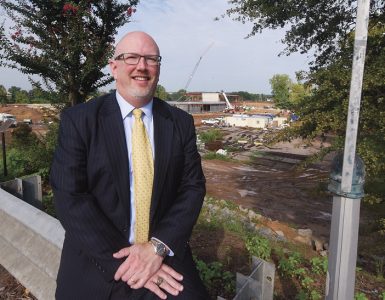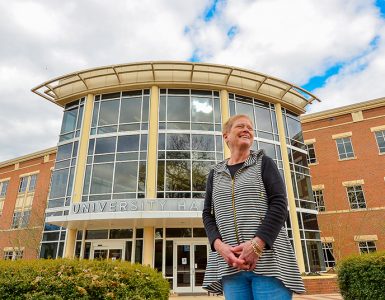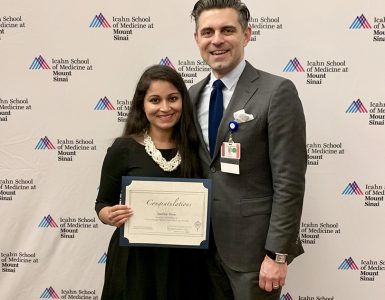It’s a gorgeous spring morning in Augusta, Georgia. Vivid blue skies, marshmallow clouds, grass as green as an Irish glen. At 8 in the morning, the air is just this side of cool.
It’s enough to send even the most casual golfer straight to the nearest course.
And on this glorious day just a couple of weeks past the famed Masters Golf Tournament, the Forest Hills Golf Club is humming. A convivial group of about 40 senior golfers are gearing up for their standing Wednesday morning game.
Most are members of clubs from around the area, but they choose Forest Hills for its pristine greens, first-rate facilities — and the way the place makes them feel. It’s golf heaven.
Yet if it weren’t for the passion, tenacity, and resourcefulness of a group of local community and business leaders — all members of the Augusta Golf Association —the Forest Hills Golf Course might be only a distant memory. And the university’s Division I Championship-caliber golf program may well have remained an unlikely dream.
Early Days
Founded in 1949, the Augusta Golf Association began as a social organization centered on the love of the game and comprised of members of the Augusta Country Club. Charter members included prominent local businessmen and civic leaders. Most were good friends, and many were alumni of the Academy of Richmond County, Augusta Junior College —or both — so they’d known each other for years.
Most started young in the sport, so AGA members were, from the beginning, keenly interested in helping aspiring young golfers to learn the game, and it wasn’t long before their interest and support expanded to college golf. They began by providing scholarships to student players at the Junior College of Augusta, whose team played against other small colleges and prominent high schools in the state.
Then Augusta native Carl Sanders, first as a state senator and then as governor, led the junior college to become part of the University System of Georgia under the Board of Regents in 1958 and to become the four-year Augusta College in 1964. Shortly after that, the AGA began working with then-Coach Marvin Vanover to provide funds for the first of many four-year scholarships that would be awarded to promising students and golfers.
The Rescue
By the mid-1970s, the glory days of the Forest Hills Golf Course seemed far behind it. Developed in the 1920s, it’s where golf legend Bobby Jones began his historic 1930 Grand Slam win. Through the ’20s and ’30s, the nation’s richest and most famous golf enthusiasts flocked to the course. In the ’40s, it was turned over to the military, so weary and wounded World War II veterans could grow stronger on its links while convalescing at the Oliver General military hospital.
“Our motive was a desire and commitment to continue supporting junior golf and college golf at Augusta State.”
– Don Grantham
But in 1974, a new course opened at Fort Gordon, and the one at Forest Hills was designated federal government surplus. By 1976, it was a mess. “The grass had grown up; the greens were no good anymore; and nothing was playable,” said Don Grantham, Augusta businessman and longtime member of the Augusta Golf Association.
But AGA members Grantham, R.O. Barton, Billy Dolan, and Finley Merry saw in the abandoned property the chance to acquire a home course for the fledgling Augusta College golf program and a catalyst to launch it to real success.
So they got to work.
First, they solicited then-Congressman Doug Barnard to help navigate the red tape required to acquire federal government surplus. They learned federal rules mandate that only a government agency can acquire surplus property of this type — and it has to be used in the same capacity, in this case a golf course, for 30 years into the future. Next, since they couldn’t acquire it directly, they appealed to a local member of the University System of Georgia’s Board of Regents, Toby Ivey, to help convince the BOR that they wanted an abandoned and decrepit golf course.
It was a tough sell.
They ultimately agreed that if the AGA could raise the capital to make the extensive improvements needed — estimated at a half-million dollars (or $2.1 million today) — the BOR would be the conduit for taking possession and would turn it over for use by the Augusta College Athletic Association (ACAA) to be managed by the AGA. They called a meeting of the AGA membership and laid it out: They needed each of the 100 or so members to sign a personal note to C&S Bank, pledging at least $500 in order to secure the line of credit needed to get started. Nobody hesitated.
Thus, in December 1978, the federal government transferred the property to the BOR, and the AGA and the ACAA entered into an agreement for the AGA to manage and operate the course for payment of one dollar per year. Today the AGA manages the golf course in conjunction with the university and the Augusta State University Foundation.
The Legacy
From the beginning, the AGA determined that any proceeds from the operation of the golf course would be given back to the college’s athletics program, with a focus on golf. In the second year of operation, they broke even, and in year three, they gave the athletic association just under $10,000 — the first of many gifts that would, by 2001, total more than $4 million. The funds are just the beginning of AGA member contributions to the university’s golf program over the decades. Individual members take every opportunity they can to share the course and its mission with other golf enthusiasts — and being located in “the golf capital of the world” hasn’t hurt.
Each spring, the AGA sponsors the Collegiate Invitational, which brings enthusiasts from around the U.S. in town for the Masters to visit or play the course, often including golf greats who participated in the Invitational while college students — such as Phil Michelson, Davis Love III, Justin Leonard, Dustin Johnson, and more. Though he lived more than a thousand miles away in Texas, one such guest, J. Neal Garland, was inspired to make donations toward the start of the women’s golf program at the university. Over years, Mr. Garland contributed more than $100,000 toward the golf program.
And AGA efforts have met with resounding success. Dolan was the Forest Hills Golf Committee’s first Chairman, and from the moment the course was conceived until his death in 1988, he dreamt of fielding a Division I championship team out of Augusta. His dream — and the dream of so many AGA members — came true with back-to-back Division I title wins in 2010 and 2011. It’s no stretch to draw a direct line from the AGA investment in the Forest Hills Golf Course to the world-class golf program that exists at Georgia Regents University Augusta today.
And credit goes to …
“You can have the resource, but if you don’t have the know-how to take advantage of it, you won’t get very far.” — Don Grantham, Forest Hills Golf Committee Chairman since 1988.
• Red Price, the PGA professional who managed the course from 1980 until his retirement in 2004, is universally recognized as pivotal to the success of the course. “He had a way of taking care of business without upsetting anyone,” said Grantham. “I applaud him in any way I can.”
• Darren Davenport has been the course superintendent since 2005 and is a big reason FHGC feels like “golf heaven.” “He’s done a tremendous job of keeping the course in such great condition,” Grantham said.
• Dan Elliott, PGA professional and current General Manager/Director of Golf, and Sarah Mooney, Head Golf Professional, are continuing the trend of excellence in golf course management that has seen Augusta Magazine readers continually name Forest Hills the best public golf course in Augusta.










